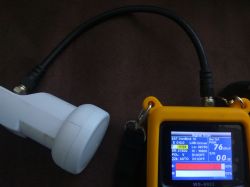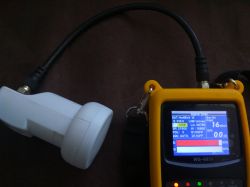FAQ
TL;DR: Seeing 92–93% or about 76 dBuV on a WS‑6933 with no lock? "I am surprised by the high signal level." Align by quality/BER, not the raw bar. [Elektroda, januszjh, post #17242944]
Why it matters: It helps DIY installers diagnose high "signal" readings that come from LNB noise, not a real satellite lock.
Quick Facts
- WS‑6933 can display ~92–93% “signal” even when the dish isn’t aimed at a satellite. [Elektroda, januszjh, post #17242944]
- Reported off‑sat reading ≈76 dBuV (≈6.3 mV) at the meter input. [Elektroda, januszjh, post #17242944]
- With the LNB disconnected, the meter dropped to about 11 dBuV. [Elektroda, januszjh, post #17243798]
- Example decoder readout while aiming: S 82% and Q 50%. [Elektroda, januszjh, post #17242944]
- Budget meter cost ≈PLN 200; pro gear around ≈PLN 3500. [Elektroda, januszjh, post #17244512]
Why does my Satlink WS‑6933 show high signal when not aimed at any satellite?
Because the meter’s "signal" bar reflects received RF power, not a confirmed lock. Broadband LNB noise can drive that bar high. In the thread, an experienced poster called this a "Normal phenomenon." Use quality/BER or lock indicators to verify alignment. "Normal phenomenon." [Elektroda, LeDy, post #17243766]
Is ~76 dBuV with no lock normal on this meter?
A user documented about 76 dBuV off‑sat on the WS‑6933. They also noted the same behavior across multiple LNBs and after a firmware change. Treat it as the meter responding to broadband noise, not as proof of a satellite signal. [Elektroda, januszjh, post #17242944]
What does ~11 dBuV mean when I unplug the LNB?
With the LNB disconnected, the meter sees only its baseline and cabling. The reported drop to about 11 dBuV confirms the LNB adds wideband power that inflates the “signal” bar. That behavior points to normal operation, not a fault. [Elektroda, januszjh, post #17243798]
Which readings should I trust on a budget meter like WS‑6933?
Prioritize lock, BER, and quality over the raw “signal” percentage. The thread explicitly recommends bringing BER to the foreground when judging alignment. "Instead of the signal level, they could bring BER to the fore." [Elektroda, januszjh, post #17243798]
My decoder shows S 82% but Q 50% while aiming. What does that mean?
Strength (S) reflects RF level at the tuner. Quality (Q) reflects demodulated signal integrity. High S with middling Q means you are close, but not peaked or not locked cleanly. Keep adjusting for maximum Q and stable lock. [Elektroda, januszjh, post #17242944]
How do I align a dish with the WS‑6933 without being fooled by noise?
Use a quality‑first workflow.
- Select the exact transponder and polarization you need.
- Aim slowly and peak the Quality or BER reading, not the Signal bar.
- Confirm lock on the intended satellite, then tighten hardware. [Elektroda, januszjh, post #17243798]
Will updating the WS‑6933 firmware fix the high "signal" off‑sat?
No. The thread author changed software and saw no difference. The high reading arises from what the meter displays and what the LNB outputs, not a firmware bug. Focus on quality/BER and confirmed lock instead. [Elektroda, januszjh, post #17242944]
Are converters (LNBs) different now than they used to be?
The thread doesn’t document a design change that explains the effect. The author tested three different LNBs with similar high readings off‑sat. That points to display behavior, not a new LNB trait. [Elektroda, januszjh, post #17242944]
Is my meter defective if I still see ~76 dBuV with the LNB disconnected?
That would be atypical. One participant challenged the idea of seeing 76 dBuV after disconnecting the converter, implying suspicion of a fault. "76 dBuV how do you disconnect the converter from the meter?" [Elektroda, Prof. SpecMiernik, post #17251351]
Will a professional meter (~PLN 3500–4000) help in practice?
Yes. A pro meter gives true quality metrics (BER/MER), better demodulators, and clearer pass/fail criteria. An industry rep noted you’ll learn the difference between an indicator and a measure. "You will definitely find out what the difference ... is." [Elektroda, TELMOR_PL, post #17307420]
Is a PLN 200 WS‑6933 reasonable for occasional DIY alignment?
For infrequent, non‑professional use, the author found pro gear unnecessary. They improve or replace parts and align occasionally, making a 4k PLN meter impractical. The budget unit suffices if you follow quality/BER. [Elektroda, januszjh, post #17307492]
Why did my old diode‑buzzer finder work before but struggle now?
The author reported a recent job where the signal was binary—either present or not—with no intermediate values. That behavior makes crude buzzers hard to use. A meter with quality/BER readouts helps overcome this. [Elektroda, januszjh, post #17242944]
What products were suggested as alternatives to the WS‑6933?
A vendor pointed to professional SAT/DVB‑T/CATV meters in their catalog. Those units provide proper measurements for faster, repeatable alignment and troubleshooting. Consider them if you align regularly. [Elektroda, TELMOR_PL, post #17251915]
Does a polarmount improve alignment accuracy more than a better meter?
The author argued mechanical precision from a polarmount can improve final alignment. That does not replace reliable quality metrics, but it can reduce aiming error and help repeatability. [Elektroda, januszjh, post #17244512]






